Abstract
The dopamine D2 receptors were investigated in vivo in eight neuroleptic-free patients with persistent tardive dyskinesia using positron emission tomography and 76Br-bromospiperone. The striatal receptor density, estimated by the striatum/cerebellum radioligand concentration ratio, was not elevated in patients as compared with age-matched controls but was positively correlated with the severity of orofacial dyskinesia assessed with the Abnormal Involuntary Movement Rating Scale. These results indicate that tardive dyskinesia is associated with normal levels of striatal D2 receptors but the severity of orofacial movements may depend on the relative density of striatal D2 receptors.
Full text
PDF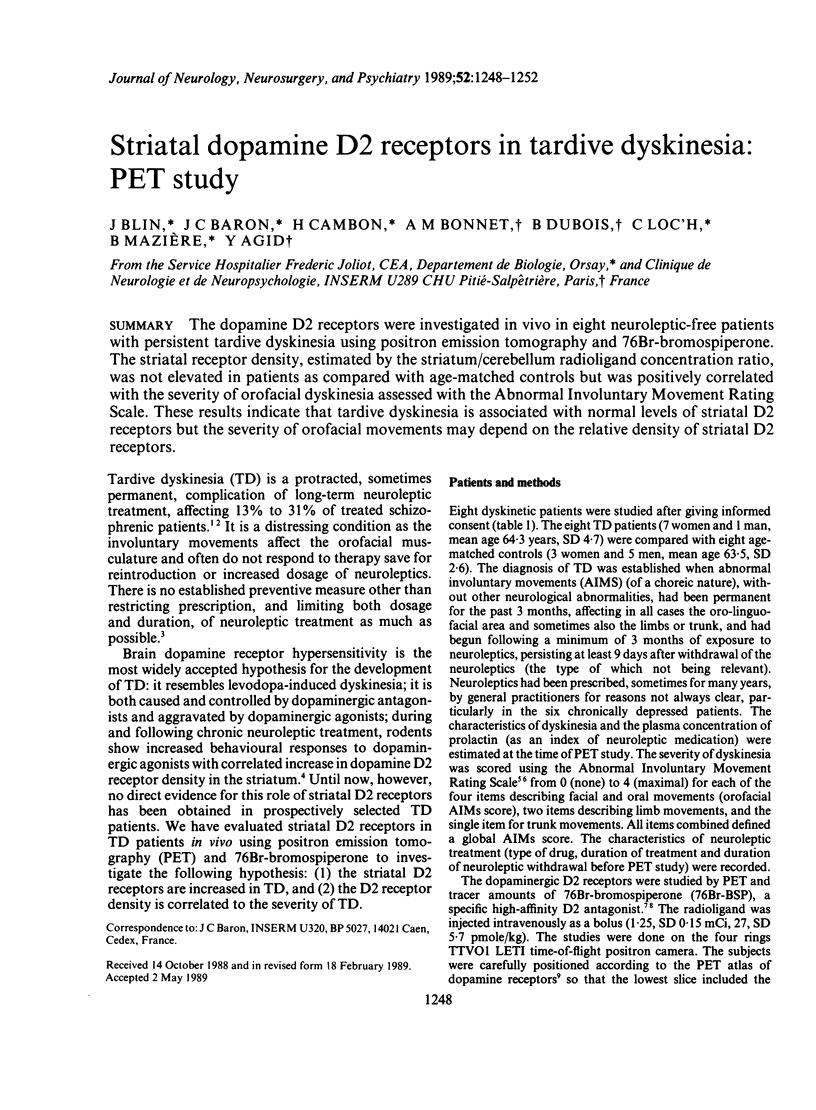
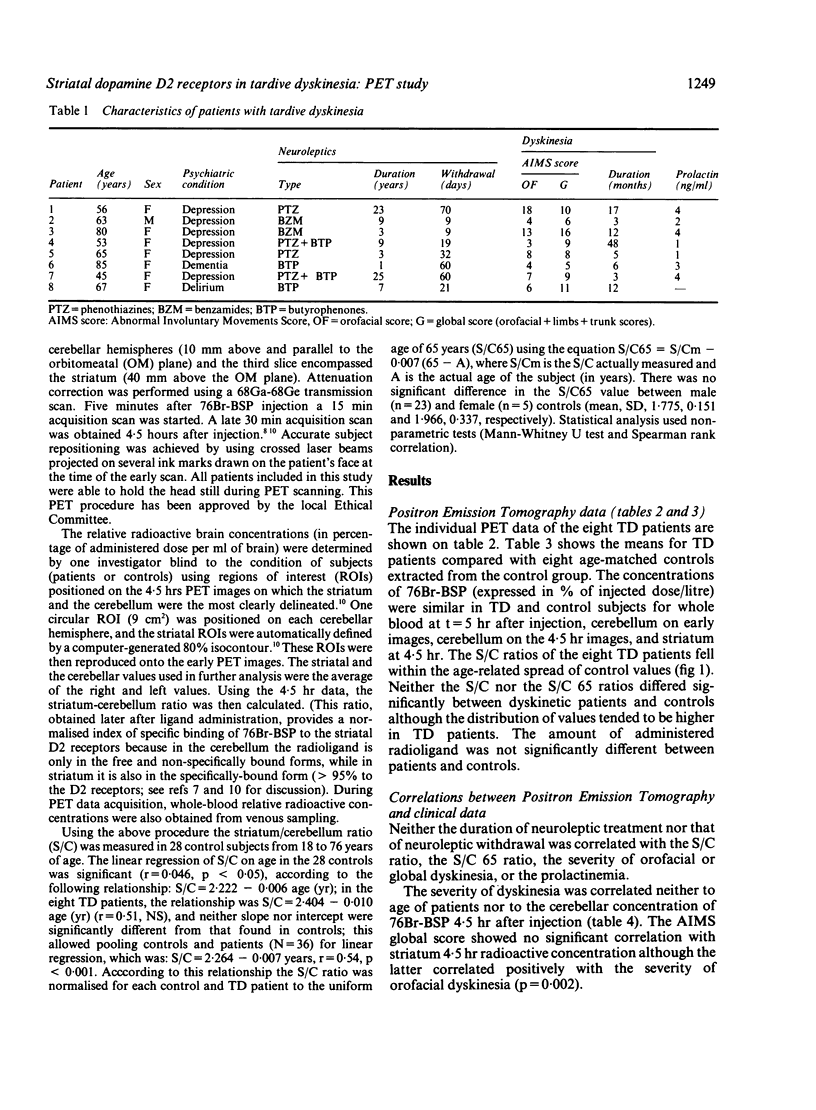
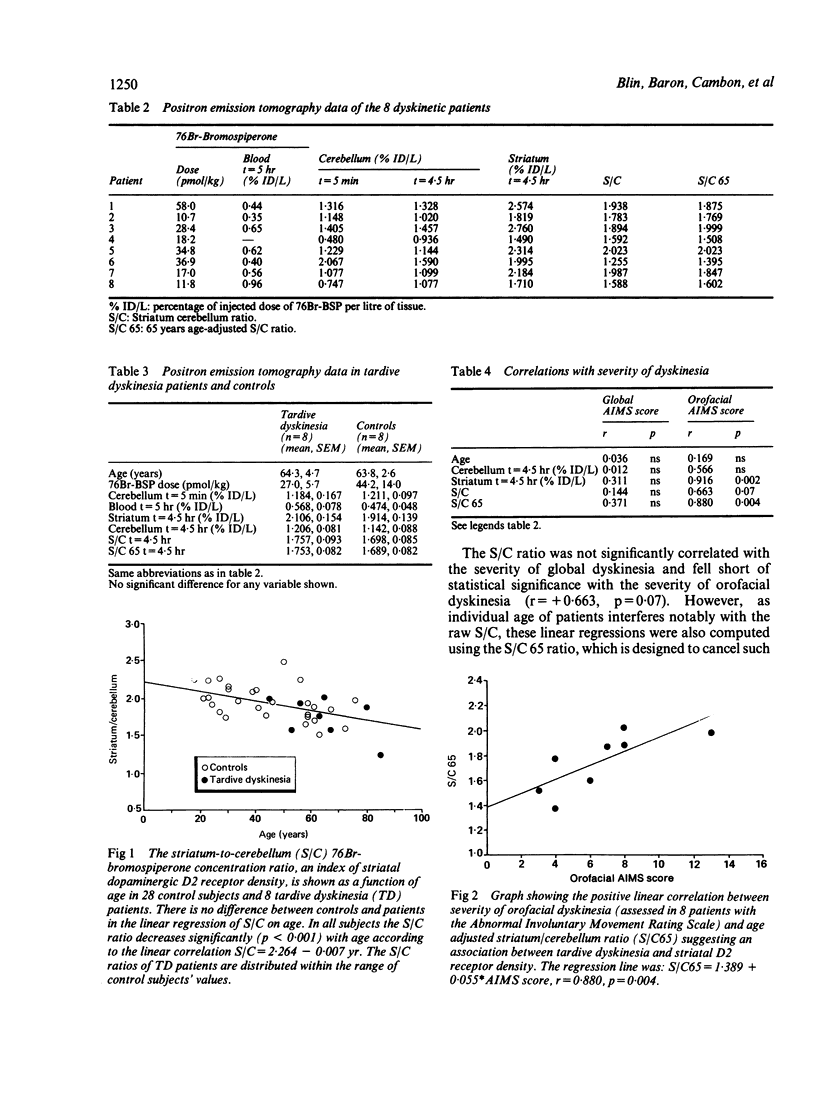
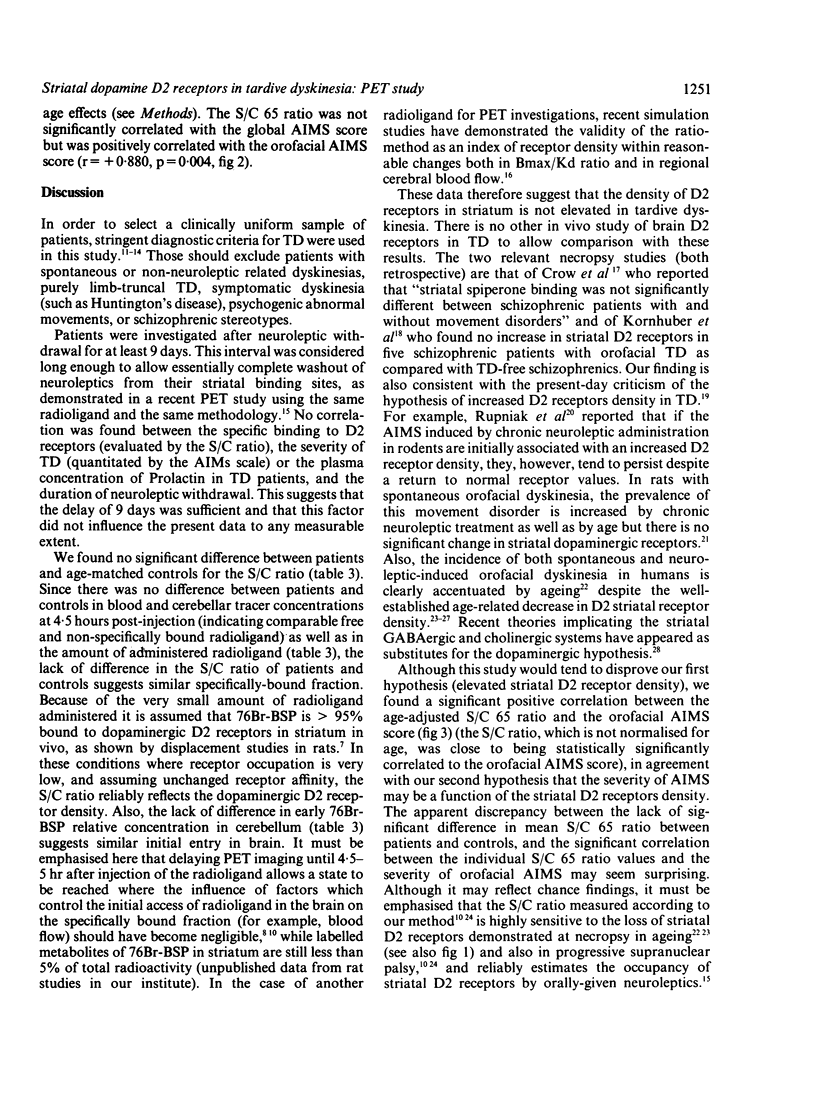
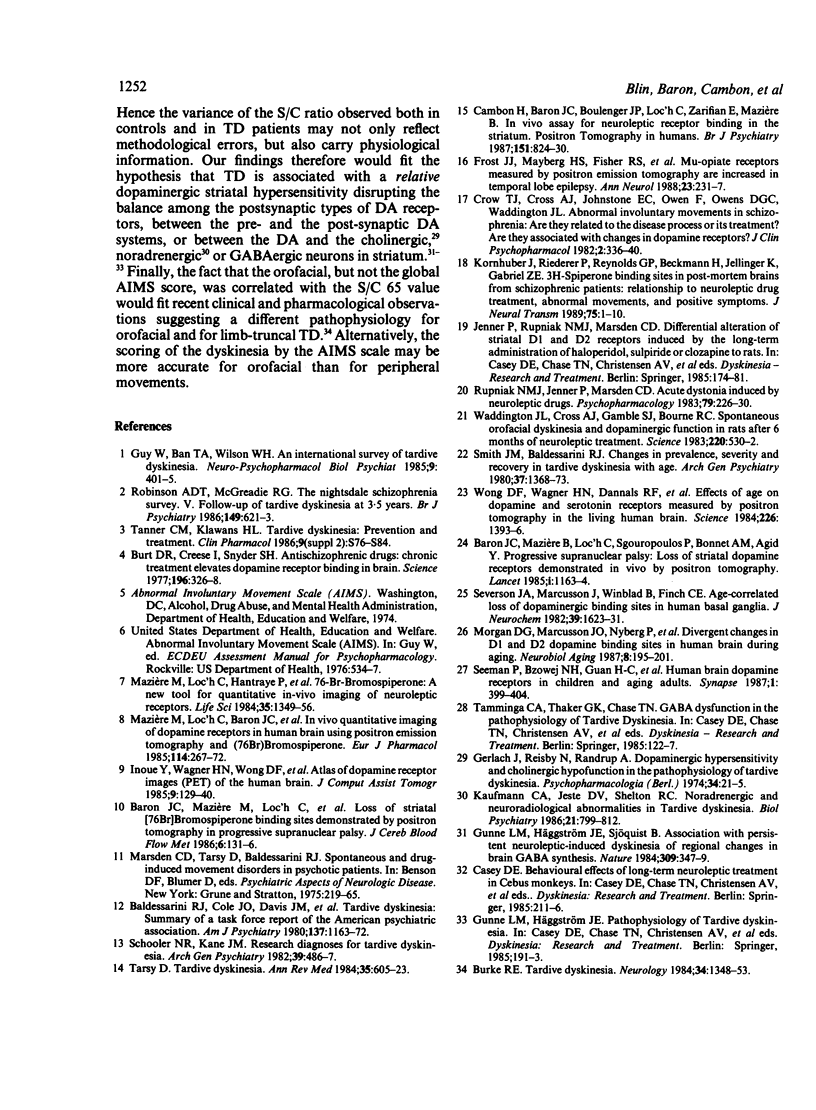
Selected References
These references are in PubMed. This may not be the complete list of references from this article.
- Baron J. C., Maziere B., Loc'h C., Sgouropoulos P., Bonnet A. M., Agid Y. Progressive supranuclear palsy: loss of striatal dopamine receptors demonstrated in vivo by positron tomography. Lancet. 1985 May 18;1(8438):1163–1164. doi: 10.1016/s0140-6736(85)92470-5. [DOI] [PubMed] [Google Scholar]
- Baron J. C., Mazière B., Loc'h C., Cambon H., Sgouropoulos P., Bonnet A. M., Agid Y. Loss of striatal [76Br]bromospiperone binding sites demonstrated by positron tomography in progressive supranuclear palsy. J Cereb Blood Flow Metab. 1986 Apr;6(2):131–136. doi: 10.1038/jcbfm.1986.26. [DOI] [PubMed] [Google Scholar]
- Burke R. E. Tardive dyskinesia: current clinical issues. Neurology. 1984 Oct;34(10):1348–1353. doi: 10.1212/wnl.34.10.1348. [DOI] [PubMed] [Google Scholar]
- Burt D. R., Creese I., Snyder S. H. Antischizophrenic drugs: chronic treatment elevates dopamine receptor binding in brain. Science. 1977 Apr 15;196(4287):326–328. doi: 10.1126/science.847477. [DOI] [PubMed] [Google Scholar]
- Cambon H., Baron J. C., Boulenger J. P., Loc'h C., Zarifian E., Maziere B. In vivo assay for neuroleptic receptor binding in the striatum. Positron tomography in humans. Br J Psychiatry. 1987 Dec;151:824–830. doi: 10.1192/bjp.151.6.824. [DOI] [PubMed] [Google Scholar]
- Casey D. E. Behavioral effects of long-term neuroleptic treatment in Cebus monkeys. Psychopharmacology Suppl. 1985;2:211–216. doi: 10.1007/978-3-642-70140-5_26. [DOI] [PubMed] [Google Scholar]
- Crow T. J., Cross A. J., Johnstone E. C., Owen F., Owens D. G., Waddington J. L. Abnormal involuntary movements in schizophrenia: are they related to the disease process or its treatment? Are they associated with changes in dopamine receptors? J Clin Psychopharmacol. 1982 Oct;2(5):336–340. [PubMed] [Google Scholar]
- Frost J. J., Mayberg H. S., Fisher R. S., Douglass K. H., Dannals R. F., Links J. M., Wilson A. A., Ravert H. T., Rosenbaum A. E., Snyder S. H. Mu-opiate receptors measured by positron emission tomography are increased in temporal lobe epilepsy. Ann Neurol. 1988 Mar;23(3):231–237. doi: 10.1002/ana.410230304. [DOI] [PubMed] [Google Scholar]
- Gerlach J., Reisby N., Randrup A. Dopaminergic hypersensitivity and cholinergic hypofunction in the pathophysiology of tardive dyskinesia. Psychopharmacologia. 1974 Jan 9;34(1):21–35. doi: 10.1007/BF00421217. [DOI] [PubMed] [Google Scholar]
- Gunne L. M., Häggström J. E., Sjöquist B. Association with persistent neuroleptic-induced dyskinesia of regional changes in brain GABA synthesis. Nature. 1984 May 24;309(5966):347–349. doi: 10.1038/309347a0. [DOI] [PubMed] [Google Scholar]
- Guy W., Ban T. A., Wilson W. H. An international survey of tardive dyskinesia. Prog Neuropsychopharmacol Biol Psychiatry. 1985;9(4):401–405. doi: 10.1016/0278-5846(85)90193-9. [DOI] [PubMed] [Google Scholar]
- Inoue Y., Wagner H. N., Jr, Wong D. F., Links J. M., Frost J. J., Dannals R. F., Rosenbaum A. E., Takeda K., Di Chiro G., Kuhar M. J. Atlas of dopamine receptor images (PET) of the human brain. J Comput Assist Tomogr. 1985 Jan-Feb;9(1):129–140. doi: 10.1097/00004728-198501000-00024. [DOI] [PubMed] [Google Scholar]
- Jenner P., Rupniak N. M., Marsden C. D. Differential alteration of striatal D-1 and D-2 receptors induced by the long-term administration of haloperidol, sulpiride or clozapine to rats. Psychopharmacology Suppl. 1985;2:174–181. doi: 10.1007/978-3-642-70140-5_21. [DOI] [PubMed] [Google Scholar]
- Kaufmann C. A., Jeste D. V., Shelton R. C., Linnoila M., Kafka M. S., Wyatt R. J. Noradrenergic and neuroradiological abnormalities in tardive dyskinesia. Biol Psychiatry. 1986 Jul;21(8-9):799–812. doi: 10.1016/0006-3223(86)90245-3. [DOI] [PubMed] [Google Scholar]
- Kornhuber J., Riederer P., Reynolds G. P., Beckmann H., Jellinger K., Gabriel E. 3H-spiperone binding sites in post-mortem brains from schizophrenic patients: relationship to neuroleptic drug treatment, abnormal movements, and positive symptoms. J Neural Transm. 1989;75(1):1–10. doi: 10.1007/BF01250639. [DOI] [PubMed] [Google Scholar]
- Mazière B., Loc'h C., Baron J. C., Sgouropoulos P., Duquesnoy N., D'Antona R., Cambon H. In vivo quantitative imaging of dopamine receptors in human brain using positron emission tomography and [76Br]bromospiperone. Eur J Pharmacol. 1985 Aug 27;114(3):267–272. doi: 10.1016/0014-2999(85)90369-3. [DOI] [PubMed] [Google Scholar]
- Mazière B., Loc'h C., Hantraye P., Guillon R., Duquesnoy N., Soussaline F., Naquet R., Comar D., Mazière M. 76Br-bromospiroperidol: a new tool for quantitative in-vivo imaging of neuroleptic receptors. Life Sci. 1984 Sep 24;35(13):1349–1356. doi: 10.1016/0024-3205(84)90391-6. [DOI] [PubMed] [Google Scholar]
- Morgan D. G., Marcusson J. O., Nyberg P., Wester P., Winblad B., Gordon M. N., Finch C. E. Divergent changes in D-1 and D-2 dopamine binding sites in human brain during aging. Neurobiol Aging. 1987 May-Jun;8(3):195–201. doi: 10.1016/0197-4580(87)90002-9. [DOI] [PubMed] [Google Scholar]
- Robinson A. D., McCreadie R. G. The Nithsdale schizophrenia survey. V. Follow-up of tardive dyskinesia at 3 1/2 years. Br J Psychiatry. 1986 Nov;149:621–623. doi: 10.1192/bjp.149.5.621. [DOI] [PubMed] [Google Scholar]
- Rupniak N. M., Jenner P., Marsden C. D. Cholinergic manipulation of perioral behaviour induced by chronic neuroleptic administration to rats. Psychopharmacology (Berl) 1983;79(2-3):226–230. doi: 10.1007/BF00427817. [DOI] [PubMed] [Google Scholar]
- Schooler N. R., Kane J. M. Research diagnoses for tardive dyskinesia. Arch Gen Psychiatry. 1982 Apr;39(4):486–487. doi: 10.1001/archpsyc.1982.04290040080014. [DOI] [PubMed] [Google Scholar]
- Severson J. A., Marcusson J., Winblad B., Finch C. E. Age-correlated loss of dopaminergic binding sites in human basal ganglia. J Neurochem. 1982 Dec;39(6):1623–1631. doi: 10.1111/j.1471-4159.1982.tb07996.x. [DOI] [PubMed] [Google Scholar]
- Smith J. M., Baldessarini R. J. Changes in prevalence, severity, and recovery in tardive dyskinesia with age. Arch Gen Psychiatry. 1980 Dec;37(12):1368–1373. doi: 10.1001/archpsyc.1980.01780250054006. [DOI] [PubMed] [Google Scholar]
- Tamminga C. A., Thaker G. K., Chase T. N. GABA dysfunction in the pathophysiology of tardive dyskinesia. Psychopharmacology Suppl. 1985;2:122–127. doi: 10.1007/978-3-642-70140-5_16. [DOI] [PubMed] [Google Scholar]
- Tanner C. M., Klawans H. L. Tardive dyskinesia: prevention and treatment. Clin Neuropharmacol. 1986;9 (Suppl 2):S76–S84. [PubMed] [Google Scholar]
- Tardive dyskinesia: summary of a Task Force Report of the American Psychiatric Association. By the Task Force on Late Neurological Effects of Antipsychotic Drugs. Am J Psychiatry. 1980 Oct;137(10):1163–1172. doi: 10.1176/ajp.137.10.1163. [DOI] [PubMed] [Google Scholar]
- Tarsy D., Baldessarini R. J. Tardive dyskinesia. Annu Rev Med. 1984;35:605–623. doi: 10.1146/annurev.me.35.020184.003133. [DOI] [PubMed] [Google Scholar]
- Waddington J. L., Cross A. J., Gamble S. J., Bourne R. C. Spontaneous orofacial dyskinesia and dopaminergic function in rats after 6 months of neuroleptic treatment. Science. 1983 Apr 29;220(4596):530–532. doi: 10.1126/science.6132447. [DOI] [PubMed] [Google Scholar]
- Wong D. F., Wagner H. N., Jr, Dannals R. F., Links J. M., Frost J. J., Ravert H. T., Wilson A. A., Rosenbaum A. E., Gjedde A., Douglass K. H. Effects of age on dopamine and serotonin receptors measured by positron tomography in the living human brain. Science. 1984 Dec 21;226(4681):1393–1396. doi: 10.1126/science.6334363. [DOI] [PubMed] [Google Scholar]


